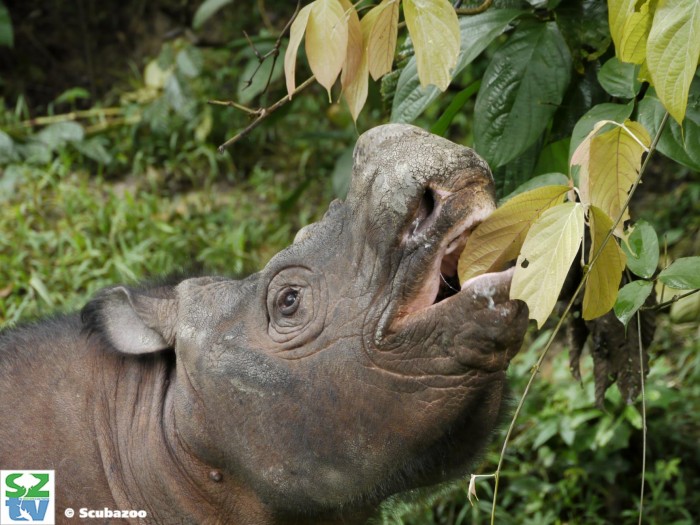A study led by researchers at the Stockholm Paleogenetics Centre showed surprisingly low levels of inbreeding in the remaining Sumatran rhino population. The researchers sequenced the genomes of 21 modern and historical rhino specimens, which allowed them to investigate the genetic health of the rhinos living today and one of the most recently extinct populations. The findings were published today (April 26, 2021) in the journal Nature Communications.

With fewer than 100 Sumatran rhinos left, it is one of the most endangered mammal species in the world. Recent reports of health issues and low fertility rates have raised concerns about inbreeding of the remaining populations. However, little is known about the genetic condition of these mysterious rhinos.
A picture of Kertam, a young male Sumatran rhino from Borneo, whose genome was sequenced in this study. Source: Scuba Zoo
To investigate whether Sumatran rhinos are threatened by genetic factors, the researchers sequenced the genomes of 16 individuals representing the present populations of Borneo and Sumatra, as well as those that recently became extinct in Peninsular Malaysia. This allows them to estimate inbreeding levels, genetic variation, and the frequency of potentially harmful mutations in the population. In addition, by sequencing the genomes of five historical samples, the researchers could investigate the genetic consequences of a severe decline in population numbers over the past 100 years.
Researchers believe that the relatively low level of inbreeding in today's rhinos is due to the fact that the decline in population size is recent. This means that inbreeding has not yet caught up with the current small population size. This is good news for conservation management of the remaining population, as it means there is still time to preserve the genetic diversity of the species. However, the researchers also found that there are many potentially harmful mutations hidden in the genomes of these individuals, which could be bad news for the future.
Nicolas Dussex, a postdoctoral fellow at the Center for Ancient Genetics who is also co-leader of the study, cautioned: "Unless the size of the population begins to expand, inbreeding levels are likely to begin to rise, making genetic diseases more common." "
A picture of Kertam, a young male from Borneo, a Sumatran rhinoceros, whose genome was sequenced in this study. Source: Scuba Zoo
The team found a grim sign from the recently extinct populations of Peninsular Malaysia that a similar situation could soon occur in the remaining populations of Borneo and Sumatra. A comparison of the historical and modern genomes suggests that peninsular Malaysian populations experienced rapid growth in inbreeding levels prior to extinction. In addition, the researchers observed changes in the frequency of potentially harmful mutations, which is consistent with inbreeding inhibition, a phenomenon in which offspring produced by closely related parents have genetic diseases. These results mean that if the inbreeding levels of the remaining two populations begin to increase, they may suffer a similar fate.
"The Sumatran rhino, though, is not already completely bogged down. But at least our findings offer a way forward, where we may still be able to save much of the species' genetic diversity," said Love Dalén, a professor of evolutionary genetics at the Center for Paleogenetics.
To minimize the risk of extinction, the researchers say the top priority is to increase population size. They also suggested that actions could be taken to allow genes to be exchanged between Borneo and Sumatra, for example through the transfer of individuals or the use of artificial insemination. Comparing the genomes of the two islands, there is no evidence that this gene exchange leads to the introduction of genes that are less well suited to the local environment. The researchers also note that genome sequencing can be used as a tool to identify specific individuals with a small number of potentially harmful mutations that would be particularly well suited to this type of gene exchange.
From a broader perspective, the study highlights the potential of modern genome sequencing techniques to guide global efforts to protect endangered species. The research, supported by the National Genomics Infrastructure of the Swedish Science life laboratory, is a collaboration of researchers from several different countries, including geneticists and conservation management and reproductive biology experts.